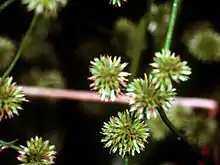| Juncus scirpoides | |
|---|---|
 | |
| Flowers | |
_BHL3347103.jpg.webp) | |
| Botanical illustration | |
| Scientific classification | |
| Kingdom: | Plantae |
| Clade: | Tracheophytes |
| Clade: | Angiosperms |
| Clade: | Monocots |
| Clade: | Commelinids |
| Order: | Poales |
| Family: | Juncaceae |
| Genus: | Juncus |
| Species: | J. scirpoides |
| Binomial name | |
| Juncus scirpoides | |
| Synonyms[1] | |
|
List
| |
Juncus scirpoides, the needlepod rush, is a species of flowering plant in the family Juncaceae, native to the central and eastern United States.[1][2] It prefers wet sandy soils, and among the many places it grows it is common in the enigmatic Carolina bays.[3]
References
- 1 2 "Juncus scirpoides Lam". Plants of the World Online. Board of Trustees of the Royal Botanic Gardens, Kew. 2017. Retrieved 3 July 2021.
- ↑ "Juncus scirpoides Lam. needlepod rush". USDA Plants Database. United States Department of Agriculture, Natural Resources Conservation Service. Retrieved 3 July 2021.
- ↑ Luken, James O. (2005). "Dionaea muscipula (Venus Flytrap) Establishment, Release, and Response of Associated Species in Mowed Patches on the Rims of Carolina Bays". Restoration Ecology. 13 (4): 678–684. doi:10.1111/j.1526-100X.2005.00086.x.
This article is issued from Wikipedia. The text is licensed under Creative Commons - Attribution - Sharealike. Additional terms may apply for the media files.